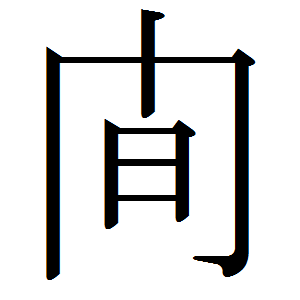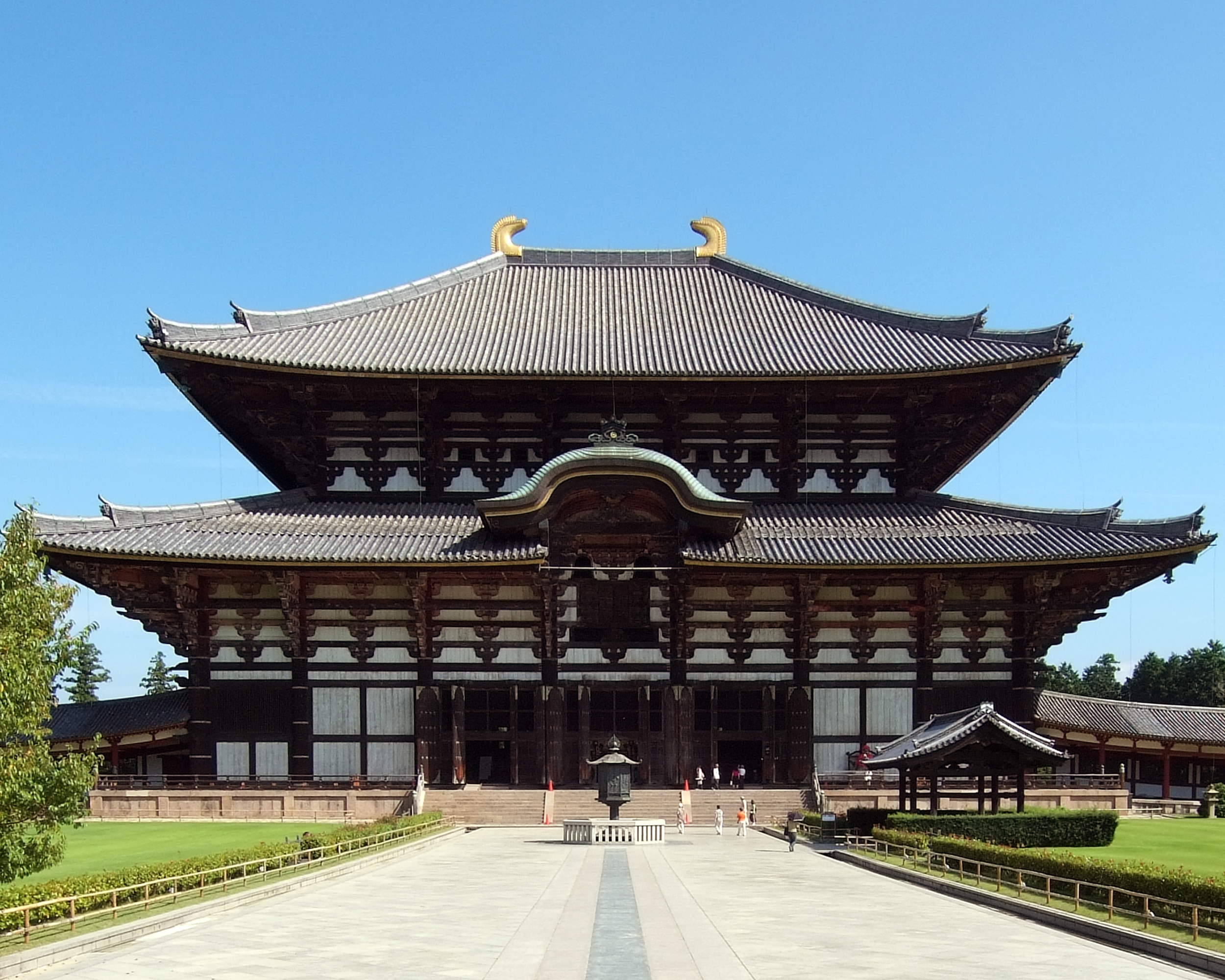Jian (unit) on:
[Wikipedia]
[Google]
[Amazon]
 The is a
The is a
 Among English loanwords of Japanese origin, both ''ken'' and '' ma'' are derived from readings of the same character .
This kanji graphically combines "door" and "sun". The earlier variant character was written with "moon" rather than "sun", depicting "A door through the crevice of which the moonshine peeps in".
The diverse Japanese pronunciations of include '' on'yomi'' Sino-Chinese readings (from ''jian'' or "room; between; gap; interval") of ''kan'' "interval; space; between; among; discord; favorable opportunity" or ''ken'' "six feet"; and '' kun'yomi'' native Japanese readings of ''ai'' "interval; between; medium; crossbred", ''aida'' or ''awai'' "space; interval; gap; between; among; midway; on the way; distance; time; period; relationship", or ''ma'' "space; room; interval; pause; rest (in music); time; a while; leisure; luck; timing; harmony".
Among English loanwords of Japanese origin, both ''ken'' and '' ma'' are derived from readings of the same character .
This kanji graphically combines "door" and "sun". The earlier variant character was written with "moon" rather than "sun", depicting "A door through the crevice of which the moonshine peeps in".
The diverse Japanese pronunciations of include '' on'yomi'' Sino-Chinese readings (from ''jian'' or "room; between; gap; interval") of ''kan'' "interval; space; between; among; discord; favorable opportunity" or ''ken'' "six feet"; and '' kun'yomi'' native Japanese readings of ''ai'' "interval; between; medium; crossbred", ''aida'' or ''awai'' "space; interval; gap; between; among; midway; on the way; distance; time; period; relationship", or ''ma'' "space; room; interval; pause; rest (in music); time; a while; leisure; luck; timing; harmony".
 The ''ken'' is based on the Chinese ''jian''. It uses the same Chinese character as the Korean '' kan''.
A building's proportions were (and, to a certain extent, still are) measured in ''ken'', as for example in the case of Enryaku-ji's ''Konponchū-dō'' ( Main Hall), which measures 11×6 bays (37.60 m × 23.92 m), of which 11×4 are dedicated to the worshipers. Inside buildings, available space was often divided in squares measuring one ''ken'' across, and each square was then called a , the term written with the same Chinese character as ''ken''. Traditional buildings usually measure an odd number of bays, for example 3×3 or 5×5. A type of temple's gate called ''
The ''ken'' is based on the Chinese ''jian''. It uses the same Chinese character as the Korean '' kan''.
A building's proportions were (and, to a certain extent, still are) measured in ''ken'', as for example in the case of Enryaku-ji's ''Konponchū-dō'' ( Main Hall), which measures 11×6 bays (37.60 m × 23.92 m), of which 11×4 are dedicated to the worshipers. Inside buildings, available space was often divided in squares measuring one ''ken'' across, and each square was then called a , the term written with the same Chinese character as ''ken''. Traditional buildings usually measure an odd number of bays, for example 3×3 or 5×5. A type of temple's gate called ''
Taisha-zukuri
accessed on December 1, 2009 The distance between pillars was standardized very early and started being used as a unit of measurement. Land area in particular was measured using the ''ken'' as a basis. The unit was born out of the necessity to measure land surface to calculate taxes. At the time of Toyotomi Hideyoshi (16th century), the ''ken'' was about , but around 1650 the Tokugawa shogunate reduced it to specifically to increase taxes. After the Edo period, the ''ken'' started to be called .Iwanami Kōjien
Japanese Art Net User System (JAANUS)
Dictionary of Japanese Architectural and Art Historical Terminology, articles ''Kasuga-zukuri'', ''Ken'' and ''Kondō''. Accessed on May 6, 2009 * Iwanami Japanese dictionary, 6th Edition (2008), DVD version {{Japanese architectural elements Japanese architectural features Units of length
traditional Japanese unit
Traditional Japanese units of measurement or the shakkanhō (, "''shaku–kan'' system") is the traditional system of measurement used by the people of the Japanese archipelago. It is largely based on the Chinese system, which spread to Japan and ...
of length, equal to six Japanese feet
or Japanese foot is a Japanese unit of length derived (but varying) from the Chinese , originally based upon the distance measured by a human hand from the tip of the thumb to the tip of the forefinger (compare span). Traditionally, the length v ...
(''shaku''). The exact value has varied over time and location but has generally been a little shorter than .JAANUS It is now standardized as 1.82 m.
Although mostly supplanted by the metric system, this unit is a common measurement in Japanese architecture
has been typified by wooden structures, elevated slightly off the ground, with tiled or thatched roofs. Sliding doors (''fusuma'') and other traditional partitions were used in place of walls, allowing the internal configuration of a space to ...
, where it is used as a proportion for the intervals between the pillars of traditional-style buildings. In this context, it is commonly translated as "bay". The length also appears in other contexts, such as the standard length of the ''bō
A ''bō'' (棒: ぼう), ''bong'' (Korean), ''pang'' (Cantonese), ''bang'' (Mandarin), or ''kun'' (Okinawan) is a staff weapon used in Okinawa. ''Bō'' are typically around and used in Okinawan martial arts, while being adopted into Japanese ar ...
'' staff in Japanese martial arts
Japanese martial arts refers to the variety of martial arts native to the country of Japan. At least three Japanese terms (''budō'', ''bujutsu'', and ''bugei'') are used interchangeably with the English phrase Japanese martial arts.
The usage ...
and the standard dimensions of the tatami mats. As these are used to cover the floors of most Japanese houses, floor surfaces are still commonly measured not in square meters but in "tatami" which are equivalent to half of a square ken.
Word
 Among English loanwords of Japanese origin, both ''ken'' and '' ma'' are derived from readings of the same character .
This kanji graphically combines "door" and "sun". The earlier variant character was written with "moon" rather than "sun", depicting "A door through the crevice of which the moonshine peeps in".
The diverse Japanese pronunciations of include '' on'yomi'' Sino-Chinese readings (from ''jian'' or "room; between; gap; interval") of ''kan'' "interval; space; between; among; discord; favorable opportunity" or ''ken'' "six feet"; and '' kun'yomi'' native Japanese readings of ''ai'' "interval; between; medium; crossbred", ''aida'' or ''awai'' "space; interval; gap; between; among; midway; on the way; distance; time; period; relationship", or ''ma'' "space; room; interval; pause; rest (in music); time; a while; leisure; luck; timing; harmony".
Among English loanwords of Japanese origin, both ''ken'' and '' ma'' are derived from readings of the same character .
This kanji graphically combines "door" and "sun". The earlier variant character was written with "moon" rather than "sun", depicting "A door through the crevice of which the moonshine peeps in".
The diverse Japanese pronunciations of include '' on'yomi'' Sino-Chinese readings (from ''jian'' or "room; between; gap; interval") of ''kan'' "interval; space; between; among; discord; favorable opportunity" or ''ken'' "six feet"; and '' kun'yomi'' native Japanese readings of ''ai'' "interval; between; medium; crossbred", ''aida'' or ''awai'' "space; interval; gap; between; among; midway; on the way; distance; time; period; relationship", or ''ma'' "space; room; interval; pause; rest (in music); time; a while; leisure; luck; timing; harmony".
History
 The ''ken'' is based on the Chinese ''jian''. It uses the same Chinese character as the Korean '' kan''.
A building's proportions were (and, to a certain extent, still are) measured in ''ken'', as for example in the case of Enryaku-ji's ''Konponchū-dō'' ( Main Hall), which measures 11×6 bays (37.60 m × 23.92 m), of which 11×4 are dedicated to the worshipers. Inside buildings, available space was often divided in squares measuring one ''ken'' across, and each square was then called a , the term written with the same Chinese character as ''ken''. Traditional buildings usually measure an odd number of bays, for example 3×3 or 5×5. A type of temple's gate called ''
The ''ken'' is based on the Chinese ''jian''. It uses the same Chinese character as the Korean '' kan''.
A building's proportions were (and, to a certain extent, still are) measured in ''ken'', as for example in the case of Enryaku-ji's ''Konponchū-dō'' ( Main Hall), which measures 11×6 bays (37.60 m × 23.92 m), of which 11×4 are dedicated to the worshipers. Inside buildings, available space was often divided in squares measuring one ''ken'' across, and each square was then called a , the term written with the same Chinese character as ''ken''. Traditional buildings usually measure an odd number of bays, for example 3×3 or 5×5. A type of temple's gate called ''rōmon
The is one of two types of two-storied gate used in Japan (the other one being the ''nijūmon'', see photo in the gallery below). Even though it was originally developed by Buddhist architecture, it is now used at both Buddhist temples and Shin ...
'' can have dimensions going from 5×2 bays to the more common 3×2 bays down to even 1×1 bay. The Zen ''butsuden'' in the illustration measures 5×5 ''ken'' across externally because its 3×3 ''ken'' core ('' moya'') is surrounded by a 1-''ken'' aisle called ''hisashi
Hisashi is a masculine Japanese given name. Its meaning differs depending on the kanji used to write it.
Kanji
Single kanji used to write the name Hisashi include:
*: "long time"
*: "eternal"
*: "still"
*: "standard"
*: "complete"
*: "long"
*: "li ...
''.
The value of a ''ken'' could change from building to building, but was usually kept constant within the same structure. There can however be exceptions. Kasuga Taisha's tiny ''honden
In Shinto shrine architecture, the , also called , or sometimes as in Ise Shrine's case, is the most sacred building at a Shinto shrine, intended purely for the use of the enshrined ''kami'', usually symbolized by a mirror or sometimes by a sta ...
s dimensions, for example, are 1×1 in ''ken'', but 1.9×2.6 in meters. In the case of Izumo Taisha's ''honden'', a ''ken'' is , well above its standard value.JAANUSTaisha-zukuri
accessed on December 1, 2009 The distance between pillars was standardized very early and started being used as a unit of measurement. Land area in particular was measured using the ''ken'' as a basis. The unit was born out of the necessity to measure land surface to calculate taxes. At the time of Toyotomi Hideyoshi (16th century), the ''ken'' was about , but around 1650 the Tokugawa shogunate reduced it to specifically to increase taxes. After the Edo period, the ''ken'' started to be called .Iwanami Kōjien
References
Citations
Bibliography
Japanese Art Net User System (JAANUS)
Dictionary of Japanese Architectural and Art Historical Terminology, articles ''Kasuga-zukuri'', ''Ken'' and ''Kondō''. Accessed on May 6, 2009 * Iwanami Japanese dictionary, 6th Edition (2008), DVD version {{Japanese architectural elements Japanese architectural features Units of length